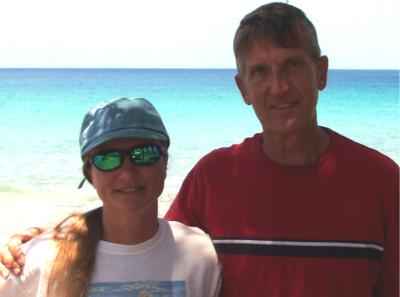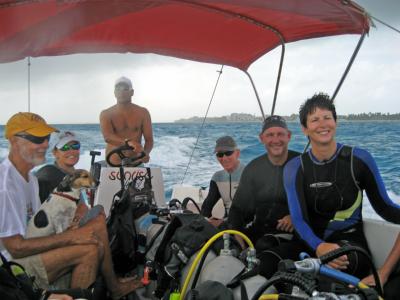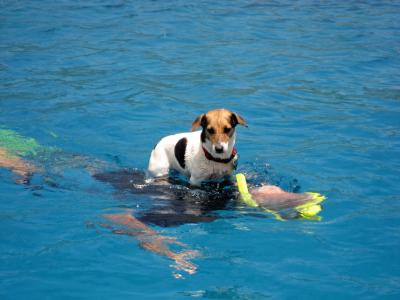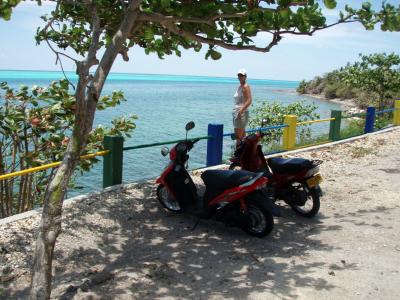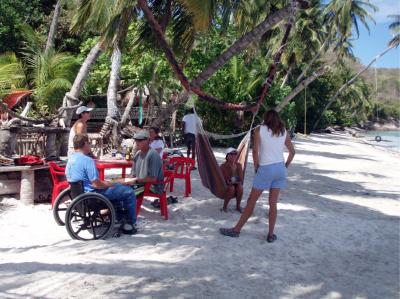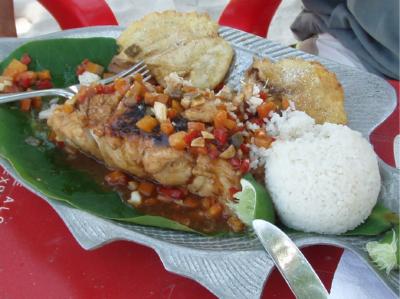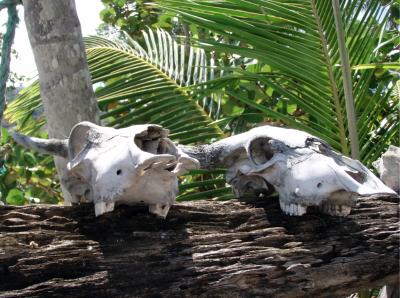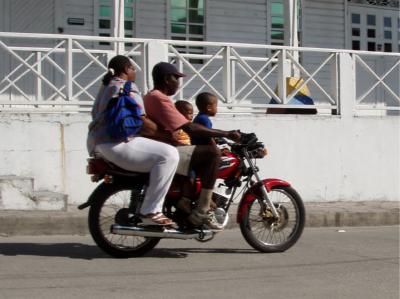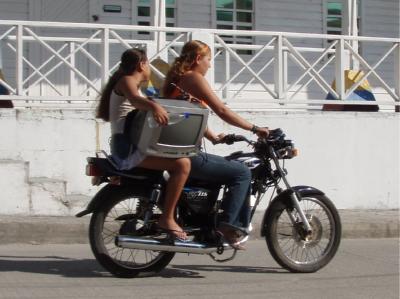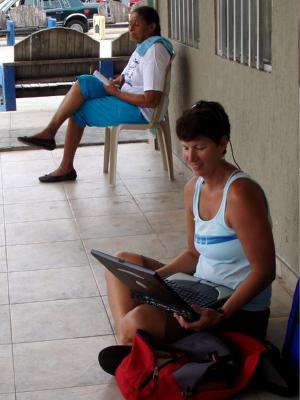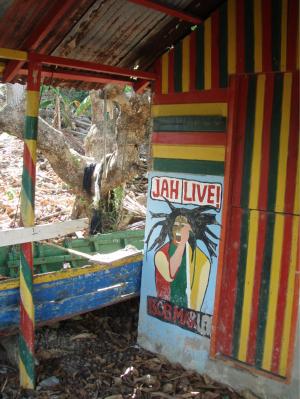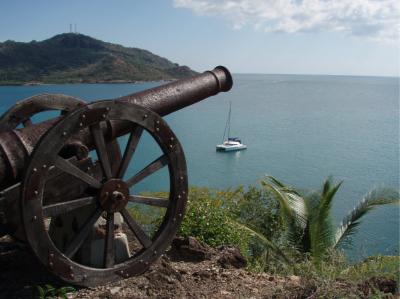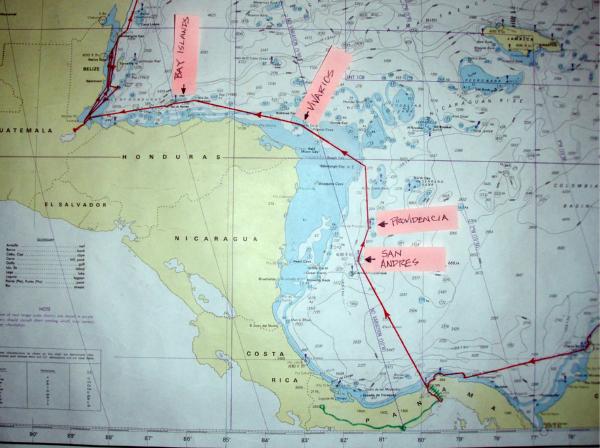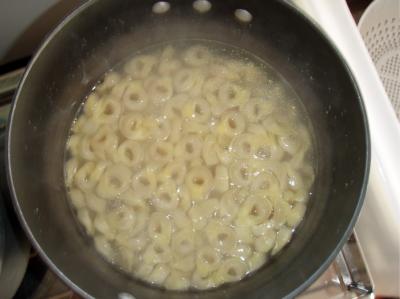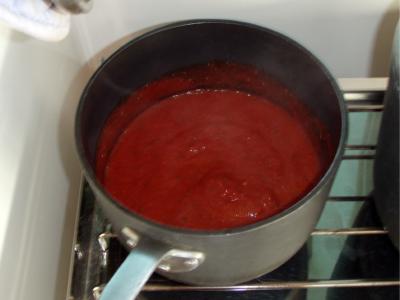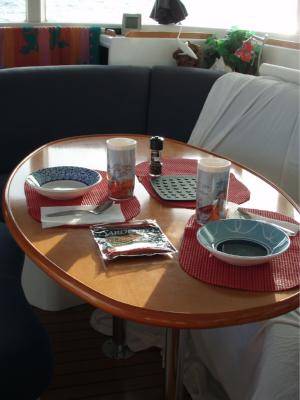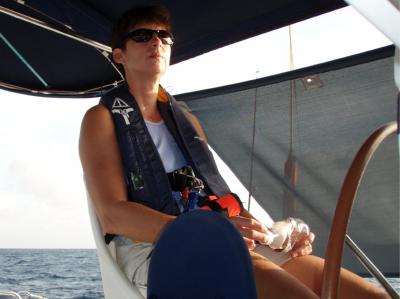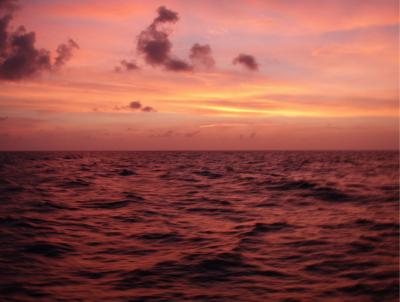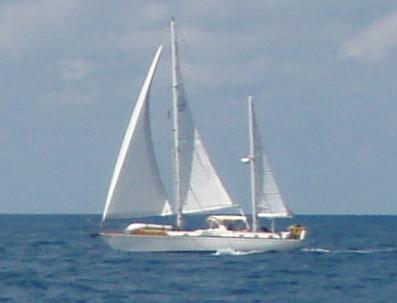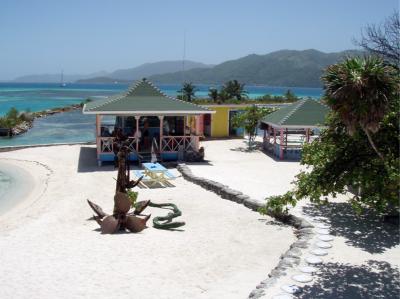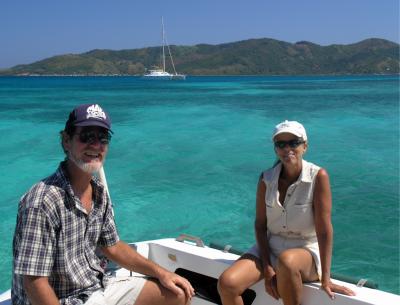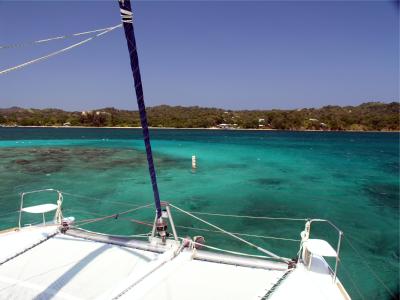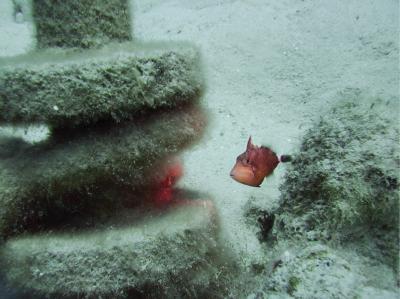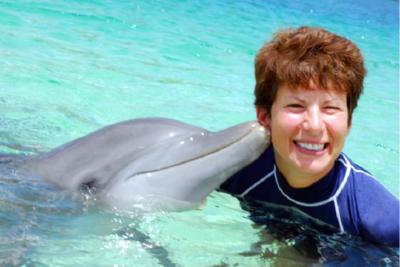
Colón, Panama to Rio Dulce, Guatemala
April 2, 2008 - May 28, 2008
As we depart Shelter Bay Marina in Colón, Panama, we reflect on yet another golden time at yet another amazing destination in the Caribbean.
It sounds like a broken record to hear me say it again, but the “cruisers’-emotional-transition process” was in full-swing and our sorrow for leaving new friends and a great country behind was immediately salved and thereafter soon eclipsed by the excitement of full sails driving Indigo Moon out to sea and toward a brand new horizon.
Just like a magic trick, the “slate is wiped clean" as we start anew toward the exciting unknown.
Departure into the open sea is the single purest “adventure component” of the cruising dream if you ask me. I am always surprised when the joy still overwhelms me. Even after years of cruising, the excitement of heading to sea is still as fresh as day one.
I guess I should not be surprised. After all, the power of new horizons is what causes “crazy” people like Melissa and me to sell everything and sail out of their local waters and not look back. Potent stuff!
So, where are we headed next? The Colombian islands of San Andres and Providencia!
This fabled archipelago of two island groups lies 480 miles northwest of Colombia and only 140 miles off the coast of Nicaragua. Our route from Colón, Panama, will take us approximately 220 miles; a straight-shot north northwest across a big patch of open seas in the Southwestern Caribbean.
San Andres is referred to as the “Hawaii of Colombia” in that it is a developed tourist destination and favorite exotic-island paradise-getaway for Colombians. Located far from their mainland, it’s a trip for the upscale crowd.
On the other hand, Providencia is a sleepy, even smaller island that has not been extensively developed and offers a slow paced atmosphere. Not a precise analogy by any means, but consider San Andres to be Oahu and Providencia to be Maui.
The Colombian islands are very small islands, tiny compared to the Hawaiian Islands. Nonetheless, the islands have a big history (the following is derived from wikipedia.com):
In 1630, Providence Island was settled by English Puritans under the aegis of the Providence Island Company. The Puritans preferred the tropical island of Providence to cold and rocky New England. They were unsuccessful in building a Colony similar to New England and instead established slave plantations and engaged in privateering which led to the capture of the Colony by the Spanish in 1641.
In the 1640s, the Puritan-controlled Commonwealth government of England tried to regain the island, but without success. In 1670, English buccaneers led by Henry Morgan took over the islands and controlled them until 1689.
In 1803, Spain designated the islands to be part of a territory administered from the province of Cartagena, Colombia.
On July 4, 1818, French Corsair Louis-Michel Aury, flying the Argentine flag, captured Providence with the help of 400 men and 14 ships. He found the island populated by English-speaking Protestant white persons and their slaves.
Aury and his team used the islands as a base to pursue Central American independence. He also extended several unaccepted offers to support Simon Bolivar in his fight for Venezuelan and Colombian independence.
After the Spanish Colonies became independent, the inhabitants of San Andres and Providence voluntarily adhered to the Republic of Gran Colombia in 1822, Colombia placed Providencia under the administration of the Magdalena Department.
But, the United Provinces of Central America (UPCA) also claimed the islands.
Gran Colombia in turn protested the UPCA's occupation of the eastern coast of Nicaragua. The UPCA broke up in 1838–1840, but Nicaragua carried on the dispute, as did Gran Colombia's successors, New Grenada and Colombia.
Colombia established a local administration (intendencia) in the islands in 1912.
In 1928, Colombia and Nicaragua signed the Esguerra-Bárcenas treaty, which gave control of the islands to Colombia. However, when the Sandinista government assumed power in Nicaragua in the 1980s, it repudiated the treaty.
Nicaragua claims that the treaty was signed under the duress of United States military pressure and military occupation and thus does not constitute a sovereign decision.
Colombia, however, argues that the treaty's final ratification in 1930 (when U.S. forces were already on their way out) confirms its validity. Colombia and Honduras signed a maritime boundary treaty in 1999 which implicitly accepts Colombian sovereignty over the islands. That is less than ten years ago.
In 2001 Nicaragua filed claims with the International Court of Justice (ICJ) over the disputed maritime boundary, claiming ownership of over 50,000 km² in the Caribbean, including the San Andrés and Providencia archipelagoes.
Colombia responded that the ICJ has no jurisdiction over the matter and increased its naval and police presence in the islands. Colombia also defended its claim in the ICJ. On December 13, 2007, the ICJ ruled that the islands were Colombian territory, but left the maritime border dispute unresolved. Colombia and Nicaragua will go through another trial to resolve these claims.
As such, there are serious, ongoing conflicts in the Western Caribbean and much of Central America, all the way from Nicaragua to Guatemala. This warrants keeping a close eye on current affairs and keeping a keen ear to the “coconut telegraph” lest part of the cruising adventure include being caught up in political conflicts. More on that later.
And while the ownership and control of these Colombian islands can be disputed until the end of time, their stunning natural beauty cannot be. The islands are exciting destinations.
But more importantly to cruisers, the islands serve as valuable stopping places for those headed north and south in the Western Caribbean. The Caribbean coasts of Costa Rica, Nicaragua, and Honduras, are infamous for pirate activity along what is known as the Mosquito Coast.
Also, considering the ongoing disputes over maritime boundaries and reports of Nicaraguan seizures of vessels found in disputed waters, coastal cruising in the Western Caribbean would be a more defiant stunt than a realistic safe float plan.
So, most cruisers headed north, for example, stay well offshore and depart Colón, or Boco Del Toros, Panama and head to San Andres and/or Providencia. After resting up, they head onward offshore around the northeast tip of Honduras to remote cays and then head west offshore from the northern coast of Honduras to the Bay Islands.
From there it is a straight hop west and a mere overnight trip to the mouth of the Sweet River (Rio Dulce) in Guatemala, where the fleet headed north customarily spends Hurricane Season before making their way back to the U.S.A.
By utilizing such a route, a cruiser can bypass Costa Rican and Nicaraguan waters, and never set foot on the Honduras’ mainland. Like long-legged frogs jumping along a trail of offshore lily pads, cruisers manage to avoid most concentrated areas of danger on the Mosquito Coast.
That’s the plan, so LET’S GO!
Colón, Panama, to San Andres, Colombia
We departed the dock at Shelter Bay Marina at first light. The channel out to sea, through the break in the giant riprap seawall, looks like it is just “right there” across Cristobal Bay when you leave the small lagoon of Shelter Bay marina. But, it takes a while to cover the distance of a couple of miles, and by the time we turned outbound in the channel and into the open sea, the sun was up over the horizon.
It takes even longer to get beyond the fleet of ships anchored offshore for many miles, each waiting their turn to transit the Panama Canal.
Many of the anchored ships were on our course to San Andres, requiring vigilance at the helm and taking the steering back from the autopilot to deviate and pass astern of various freighters from around the world.
Here is a look:
|
|
|
|
|
Finally out to sea and beyond the anchoring zone for The Canal, we were able to relax and leave the driving to the autopilot.
We took turns taking naps. On twenty-four hour hops like this we tend to cheat a little and forego any hard and fast watch schedule. We just naturally take turns catching naps in the salon.
|
|
The overnight duty on this leg was what we had come to expect. No real surprises, except on my watch I paid particular attention to two radar targets, one pretty large and one rather small, that I picked up at about 02:00. They were four miles ahead, a mile or so off my course to port.
They joined into one target and stopped. A careful look through the binoculars could not detect any running lights. The targets were invisible, cloaked in darkness, and obviously engaging in a rendezvous.
That made me very nervous.
I deviated to starboard to increase my CPA (closest point of approach) to two miles instead of one.
I continued to watch in the binoculars for the next forty-five minutes as we got closer and closer. As I came abreast of the targets, both boats suddenly flipped on running lights and began moving away from each other, one headed north and one headed east straight at ME!
Here we go!
I took a deep breath and stayed my course. The vessel was picking up speed and now doing over fifteen knots. At about a half mile away, it veered off and headed due south. I could then see, by way of its lights and silhouette through binoculars that it was a 45 to 55 foot sportfishing yacht with a tall “tuna tower” and it was “hooked-up” (running fast).
The lights on the smaller boat headed north were low to the water. It was running even faster, probably a multiple-outboard powerboat heading directly at San Andres.
What were they up to? Why the forty-five minute meeting far offshore? Why no running lights? Why come give me a look see? One can only speculate, but drug smuggling sure does “fall out on the table” first.
The two mystery vessels’ lights disappeared over the horizon quickly, and within forty-five minutes, they were both too distant to paint a decent target on radar and both were lost completely at about eighteen miles away.
Like heading toward Venezuela in 2006, we knew that heading into the Northwest Caribbean would require heightened risks and this first strange occurrence ushered in the awareness of entering an arena that demands homework and informed awareness.
As dawn broke, I did my usual routine of inspecting the decks for errant flying fish and gave all victims a proper burial at sea.
The seas were big but we had good winds and a good sailing angle and it had been a very nice passage by Northwestern Caribbean standards. What do I mean by that? Well, it’s tougher here than in the Eastern Caribbean. Currents running west and north through the Yucatan Channel stack up against Costa Rica, Nicaragua and Honduras. Swells build up near the northern peninsula of Venezuela and radiate west. Basically, eastbound currents, swells, waves and winds all boil in the dead-end cul-de-sac of the Western Caribbean.
And, in these more-challenging seas, passages always require a twenty to thirty hour overnighter to get to the next island stopping point.
Gone are the lazy-day carefree sun-tanning novel-reading fun-fishing day hops down the Eastern Caribbean where the next island is visible when you depart at 09:00 and arrive fully refreshed at 15:00.
Add on top of all that the unpredictability of weather in the wild Western Caribbean. Local conditions often confound professional weather forecasters. Localized thirty-five knot winds can blow for twenty-four hours at one island while just fifty miles away it blows in the teens as forecasted. These mystery weather hotspots make the Western Caribbean all the more daunting.
Anyway, the point is that our first foray into the Western Caribbean proper was a nice one, all things considered.
I was a bit edgy about entering the complicated reef system into the anchorage at San Andres. On the chart it looked pretty complicated with many twists and turns. I was delighted, however, to find the channels extremely well-marked with some of the nicest buoys you’ll find in the whole Caribbean. It was a walk in the park through the beautiful turquoise waters of Colombia’s favorite island paradise.
We anchored just off of Nene’s Marina and rested up.
Here are a few pictures:
|
|
|
|
In just a day we were into the groove of San Andres. Sunset sailing vessels, most notably an old trimaran and a fake pirate ship, made the rounds of the several square miles of protected reef area, all with salsa music blaring and scantily-clad and well-oiled vacationers gyrating and partying. These boats loved to come very close to us at anchor.
Early on I made the mistake of making monkey-shines at one of them and the crowd went nuts and loved it. Those Colombians are a fun-loving bunch. Well, that insured very close passes by the boats, day after day, and, of course, repeat performances by me.
Ashore, San Andres is pretty nifty! There are very nice shopping areas, dive shops, good restaurants, golf cart rentals, fine hotels, you name it. There is one service that is a little “thin” and that is the grocery stores. I guess well-healed vacationers eat out at the hotels because there is not really a decent grocery store to be found on the island.
So, if you pass through this area, load up on provisions in Colón, Panama to the south, or the Bay Islands of Honduras to the north, and count on slim pickings in between.
We enjoyed meeting Nene and used his marina for a dinghy dock. He has a little store there and will order cases of sodas or beer for you, etc.
Also, the agent will come there and handle Customs and Immigrations for you. Beware, though, that cruising guides for the Northwestern Caribbean are seriously out of date. For example, the Cruising Guide indicates that you should hail the “Livingston” agency and that Mr. Livingston is the contact upon arrival. Unfortunately, it turns out Mr. Livingston died a while back. Thus, there is an unfortunate situation wherein the VHF radio crackles sporadically with new arrivals hailing a dead man.
New arrivals should anchor, hail NENE’s Marina, and go in by dinghy. Nene can arrange for an agent to meet you at his dock and the agent will have Customs come to the marina as well. Then the agent will take your passports to Immigrations and come back later in the day with all the paperwork and your stamped passports. Laundry services are also available from the agent’s wife for a reasonable fee.
In the Eastern Caribbean, we never used agents. Cruisers got used to finding Customs and Immigrations on their own. But from Venezuela to Colombia to Panama to Guatemala, agents always handle the process.
That requires handing over your passports to a stranger. The first time we were asked to do so was in Venezuela where we politely refused and asked to accompany the agent throughout the entire process.
By now, however, after Venezuela, Colombia’s mainland, and Panama, we had become comfortable, right or wrong, with letting passports out of our sight, keeping photocopies just in case. We never had any trouble and we didn’t even question it anymore. Things evolve out here.
We spent quite a bit of time in San Andres, here is the photo journal:
|
|
San Andres boasts beautiful beaches, modern amenities and well developed and pleasing plazas along the shores of the main town on the southeast shore of the island.
|
|
The pace is slow, even in town, and a favorite activity is the rental of golf carts to explore the island. It is a “must do” activity. A drive around the whole island takes about two hours by golf cart, so that leaves several hours for stopping at various locations, going swimming, having lunch and taking it all in.
We did it twice, once with Paul and Malinda from the yacht Daydream, and then again with Jack and Desire from Famous Potatoes.
Much of the character of the old, pre-tourist island can still be discovered. Caribbean style architecture remains along with prominent old churches.
Also, on the first tour of the island we discovered an awesome place on the northwestern shore that had a diving board off a low cliff. Dubbed “the Aquarium” the water is as clear as crystal. It cost fifty cents to enter and they give you a piece of yesterday’s bread from the restaurant across the street to use as fish food. We were not prepared to swim on the first golf-cart tour, but on the next trip we brought a picnic lunch and swimsuits and had a BLAST!
There is also an unusual diving facility there where patrons don helmets and heavy shoes and walk along the bottom, breathing air pumped into the helmets. It did not look that great to us, but if you had never been underwater before, it was probably awesome.
Big schools of chubs, tangs and other fish are tame and waiting to be fed while snorkeling tourists laugh and shriek at the experience of being in the center of a school of bread-biting frenzied fish.
One guy got such a kick out of hearing his girlfriend scream, he kept throwing bread on her head and her back as they snorkeled, and the fish boiled all over her. Guys are so mean. I laughed until I inhaled salt water in my snorkel and almost choked to death.
Anyway, let’s go see. We’ll head inland first, to the top of the mountain and look around:
|
|
|
|
Next, we head along the shore around the north end of the island and on south along the western shores, where the sea is calm and the waters clear:
|
|
|
|
|
|
|
|
We enjoyed swimming and snorkeling and people-watching as tourists came and went from the area. What a GREAT swimming-hole and wonderful place to hang around.
After a nice swim and lunch, we continued onward. A few miles away, we rounded a point and there it was! A big catamaran awash and tied to a mooring!
YIKES! It had no mast, the salon door was open; it was swamped. Clearly a Fontaine Pajot, French-built cat in the upper thirty to lower forty foot range. You don’t see this everyday!
I inquired around the island the next day to learn the cat was abandoned in terrible weather somewhere near the Bahamas and was left dismasted to its own devices. It had just been found the day before, seventeen miles north of San Andres in the open sea, drifting westward in the currents and trade winds.
However disturbing the scene, the incident is a testament to the “unsinkable” rating of European-built catamarans. Brands such as Lagoon, Fontaine Pajot, and Catana utilize watertight bulkheads, foam sandwich construction, and other buoyant materials that actually qualify their cats to be certified unsinkable.
When you think about it, that’s pretty darn nifty! Not all cats are created equal and some catamaran brands are not certified to meet unsinkable standards and will not remain floating if totally swamped. Those “Brand X” cats will plummet to the bottom if they take on too much water. It’s a good question to ask when shopping for a cruising catamaran.
And the proof is in the pudding. The Fontaine Pajot full of water drifted across the WILD and rough central and western Caribbean and there she sits, still on the surface.
|
It does not take long to identify the unique-looking shoreline of San Andres. It is “iron shore” of the exact type found in most of the Bahamas. Nowhere else in the Caribbean have we seen such a carbon-copy of the treacherous shores of the Bahamas.
|
As much as you wish the tranquil western shores of San Andres would go on forever, they do not. But don’t be sad! Stop at the South Point Bar and check out the wood carvings and unique character of this southernmost watering hole on San Andres.
|
|
|
|
After a short visit at the South Point Bar we continued on and headed up the eastern side of the island. Dive shops and souvenir shops are everywhere. As you near the main tourist area and the city, traffic of all sorts picks up.
|
|
|
We had two great days touring San Andres.
It's a nice combination of remote beaches and a well developed town. There are very nice drug stores and tourist shops. Also, there are good restaurants. We liked one pizza place so much we went back several times to eat and afterward took a second pizza “para llavar” (to go) back to the boat.
In addition to good restaurants, there is a lot going on for a small Caribbean Island. While we were there, a Children’s Festival was held one Sunday and we just happened to stumble into it. Melissa had remarked early on when we got to San Andres that you could tell the people of the island appreciated their children and doted on them.
Here’s a look around:
|
|
|
|
|
|
|
One of the first things you notice in San Andres is the popularity of scooters. They are the vehicle of choice on this small island and you see them buzzing about with entire families aboard. No helmets, with babies and small children hanging on here and there, and “the more the merrier.” San Andres is a no-holds-barred motor scooter heaven.
There is also a new trend in scooter customization: sexy seat covers. Yep, apparently with the magic of computers and advances in printing technology, now you can enjoy the image of a sexy young “hottie” right on your scooter seat. What will they think of next?
Here is a look:
|
|
|
|
All of our adventures inland began and ended at NENE’s marina, a funky little marina with a roadside gas station in the front parking lot. There is a small convenience store there under an open pavilion, and NENE is very accommodating. Even though we anchored out, he allowed us and all the other cruisers to use his dock.
Most importantly, he’s an avid offshore fisherman. I spent time with him exchanging tales of blue water fishing and he explained that tremendous marlin stack up just along the deep drop offs and underwater canyons directly adjacent to San Andres. It’s a sportfishing paradise. Nene has a fabulous old Hatteras sportfishing boat, Island Girl, and he is an expert angler.
Nene’s marina is decorated with all sorts of old junk from boats and it’s a great place to sit in the shade and both catch and shoot the breeze while enjoying a cool drink.
|
|
|
We spent quite a while in the San Andres anchorage. One morning a pretty bad squall came through with high winds and heavy rains. Our trusty Delta anchor was pulled loose when the winds shifted 180 degrees and gusted to 35 knots, but it did its job and quickly reset itself.
One monohull was not as lucky and began dragging through the area. I jumped in the dinghy and helped the elderly couple aboard get their anchor reset before any damage was done.
Soon the storm was over. It rained so hard that it actually rained fish. I thought that was just an old wives’ tale, but sure enough, we found a small fish on deck that fell from the sky. Looking to be a juvenile horse eyed jack, this little fellow fell from the heavens. I let him dry out and kept him.
|
It is easy to see why San Andres enjoys such popularity and has earned its spot as a favorite vacation getaway.
We decided that it would be a shame not to SCUBA dive at San Andres. We had resisted because it was too far from that anchorage to get to a dive mooring by dinghy. The dive moorings are on the other side of the island.
In the end we signed on for a two tank dive trip and organized it to be a “private” trip with only cruisers in the anchorage. Participating cruisers were Sandy and Trevor from Common Crossing, Desire, Jack and their dog Lady Pitt from Famous Potatoes and Brant and Shirley from Bruja. The dive shop sent a boat out and picked us and our gear up on each boat. That makes it very convenient.
We actually dove just offshore of the Aquarium where we enjoyed our picnic and then drifted along the coast.
A true paradise, San Andres is a great place for diving and swimming.
|
|
On the last day in San Andres, we did a little provisioning and fueled up. While walking in town, I posed with the barracuda that graces the local fountain.
|
|
So, where to next? Dead into the northeasterly trade winds for a trip to the island of Providencia.
San Andres, Colombia to Providencia, Colombia
Quite often, upon departing Panama, many cruisers do not visit San Andres which lies southwest of Providencia. Instead, they head straight to Providencia because they don’t want to head easterly from San Andres into the trade winds that often blow directly out of the northeast.
We wanted to see it all, so we simply waited for a lull in the trades and went for it, motoring dead into light winds from dawn until late afternoon, reaching Providencia without too much trouble at all.
In fact, the only “downer” was that I got totally skunked in the fishing department. Three lines out and aggressive lure management, but nada! If Nene only knew; he would never let me live it down!
Nonetheless, we were happy to be in Providencia, San Andres’s “little sister” island that is the opposite of the modern, developed, tourist destination of San Andres.
Lets take a look at the trip:
|
|
|
|
|
Once the boat was settled at anchor, we went into the main dock and checked in with Immigrations and Customs. Mr. Bush is the local agent and I think he watches the anchorage. He was calling us on the VHF and giving us directions before we even dropped the dinghy down.
Mr. Bush welcomes all cruisers to Providencia and meets you at the dock. The Immigrations and Customs offices are right there dockside at the large, multi-story municipal building and the process is very easy. Also, there is a free wireless internet signal there too, so it’s a very cruiser-friendly destination.
And, in what we have come to know as typical Colombian hospitality, the check in process was fun and one of the Officers even invited us to go hiking with him on the weekend. It was also interesting to see the “wanted posters” for the capture of members of the Colombian FARC Guerrilla forces, along with various rewards. The posters deem the FARC’s most wanted as “terrorists.”
|
|
Once checked in, Mr. Bush gave us the nickel walkabout tour of “downtown” and he knows what info cruisers need: ATM, laundry, groceries, and ice cream!
|
|
|
|
On shore the next day, as we walked around, it became obvious that Providencia is also a “scooter” island and there are few cars and trucks in comparison. It looks funny to see eighty year old ladies riding sidesaddle on the back of a scooter with a twelve year old granddaughter driving. But it's commonplace. Kids of all ages and whole families pile on. Of course, no helmets are worn.
But, the traffic is slow, the pace is easy, and the island’s beauty is representative of all the adjectives in the book when it comes to describing tropical paradise destinations: an unspoiled, idyllic island surrounded by reefs teaming with sea life, all set within clear azure waters.
We threw care and caution to the wind and in the spirit of “when in Rome . . .” we rented two scooters for a day. I have owned four different motorcycles in the past (all dirt bikes), but Melissa’s one and only experience with driving motorcycles was a mini-bike when she was nine . . . and she burned her leg!
The reasons are many and the logic is sound: we should stay away from motorcycles if for no other reason that broken bones and cruising don’t mix. And the peg legs are overrated as conversation starters.
Thus, I have always been reticent to risk renting/riding scooters on our cruising adventure, but we took a chance in the extremely light traffic of remote Providencia and it turned out beautifully.
We enjoyed a trouble-free day of riding scooters around the entire island and all the joy of motorcycling that I loved so much in my teens and early twenties came rushing back. I was overwhelmed with sheer bliss (despite not being overwhelmed by horsepower).
I grinned and laughed all day.
I have described it before in previous trip reports, and keep repeating myself, but one of the most mysterious attributes of cruising is the utter randomness of finding oneself immersed in the middle of an unexpectedly priceless and perfect day. Our “scooter day” on Providencia was just such a happy day.
Here is the photo log:
|
|
|
|
|
|
|
Of course, we had no directions and no map. The island is small and we were just poking around and exploring. On a whim, I took a turn and followed and road down a gut in the mountain that looked as if it might go all the way down to the shore. Sure enough, we stumbled upon one of the most beautiful beaches imaginable.
And there we met Roland, a cool Rastafarian who runs his rustic beach bar “Rolando’s.” Rather than grapple for a fancy adjective, let’s just say that it is perfect.
We enjoyed a fresh fish lunch and lounged on the beach. There were only a handful of cruisers in Providencia while we were there, but, a few other crews showed up at Rolando’s too ( the island is pretty small) and before long we here hanging around with Roland, a few locals, and several other cruisers. It was so impromptu and perfect. We just grinned and soaked it all in.
|
|
|
|
|
|
|
After spending a few hours at Roland’s we mounted our steel horses and headed down the highway toward home. It was a great day indeed and we turned our scooters in without a scratch. So Melissa’s motorcycle record is improving. All kidding aside, I do love motorcycles so! Dangerous as they may be to the body, they are a pure and potent magic for the soul.
Along the way we stopped at Felipe’s dive shop and arranged for a scuba trip. Diving in the more remote areas of the Caribbean lends itself to more personal customer service in that most shops will send the dive boat to your anchored yacht and pick you up and drop you off right at your own “front porch.”
So, just like the dive shop did in San Andres, Felipe’s sent a boat around to fetch us and take us out to the reefs for a nice dive. One of the most unusual sights on the dive: A life-sized underwater statue of Jesus Christ at 60 feet deep. This fully-robed Jesus stands tall with arms reaching up and outward.
With typical Caribbean flair, Jesus has an Iguana on his left shoulder, and hung from the thumb of his right hand is a large Colombian flag that gently waves in the current. It was really something to see and I was sorry that I did not take the time to dig out my underwater dive camera. That image is yet one more tile in the mosaic of many things that I have seen revealing the beautiful souls of Colombians . . . that spirit they posses . . . it is so very genuine and wonderful.
|
We were in Providencia for several days and spent time in town checking e-mail, people watching, and picking up a few groceries. I also took some photos of “scooter life.”
And we took time to explore the point that lies just above where we anchored. From the boat we could see a few old cannons and statue of the Virgin Mary, so we decided to check it out!
|
|
|
|
|
After taking care of chores, we walked out to the point to see the sights. The island is very clean and there are no crowds. There is a nice walkway along the shore. We stopped and got an ice cream cone and enjoyed a casual walk along the bay.
|
|
|
|
|
|
One afternoon we took advantage of the clean and calm anchorage and got the kayak down. We snorkeled around the outer point and enjoyed the beach at the foot of Fort Warwick.
The anchorage was great except there was one experience that was a little creepy. One evening we were running the generator and had all the curtains of the salon open, with several lamps on. We were watching a movie and cooking dinner. Of course, the doors were closed and screens were on all the hatches before dusk, all in accordance with Melissa’s daily anti-mosquito routine.
As we sat down to eat, something caught my eye. . . BUGS BY THE THOUSANDS! They were piled up on the salon windows and lured by the interior lighting, especially thick on the windows nearest lamps, etc.
Hooo weeee . . . they were swarming termites and we were covered! Quick! Turn all the lights out! We were lucky to have the doors closed and screens on or it would have been a serious ordeal. The next morning I rinsed thousands of dead and dying termites off the decks and gave all the lockers a shot of bug killing fog. Luckily, the termites did not get a foothold on the Moon.
As we continued to hang around, a few more boats showed up in the anchorage. All of us were headed in the same direction, ultimately to Guatemala for hurricane season.
Catamaran Sol Surfin decided to bug out (hee hee) early with monohull Justoo, headed for the islands off Honduras. Newcomers to the anchorage, catamarans Second Wind and Neos, were also looking for good weather and we began to plot out next move with them as a fleet of three. This next leg was the first time since Venezuela that we had legitimate concerns about pirates.
The islands of San Andres and Providencia serve as safe “lily pads” to rest upon while staying offshore from the eastern shores of Costa Rica, Nicaragua and Honduras. But, after that, there is a gauntlet that cruisers do not look forward to. In fact, sailing the Western Caribbean presents some general features that are not so attractive, both natural and political.
Providencia, Colombia, to the Gorda Banks off the coasts of Nicaragua and Honduras
We were at the threshold of known pirate territory and facing a one hundred and twenty mile overnighter right through the heart of the area.
Sitting at the salon table and perusing a chart of the Western Caribbean, we gazed upon the coasts of Nicaragua and Honduras. This area of the Caribbean is known as the “ Mosquito Coast” and it is known for modern day piracy.
Several areas of the world are considered to be risky and the main lists usually include: 1) the number one piracy industry in the world operating in the infamous Straights of Malacca that run between Malaysia and Indonesia; 2) the Philippines; 3) the Arabian Peninsula; 4) the Coast of West Africa; 5) the Coasts of Venezuela and Colombia; and, 6) the area we are about to travel through, known as Mosquito Bay between Jamaica and the Coasts of Nicaragua and Honduras.
We read everything we could find on the subject. Cruisers websites described being chased by menacing steel fishing boats, one of which tried to position itself to stop one of the sailboats in one instance.
And the big fishing boats are thick. Relatively shallow banks are scattered all the way from the coastline at the boarder between Nicaragua and Honduras northeast to Jamaica.
For three hundred miles, these banks include the Gorda Banks near Nicaragua and Honduras, then the Rosalind Bank midway to Jamaica, and finally the Pedro Bank close to Jamaica.
Currents push north through the shallows of these banks and to the fishing fleet they deliver abundant catches of fish from the deep blue Caribbean Sea to the south. The currents also deliver yachts, yet another windfall for those in the fishing fleet who will also engage in piracy when an opportunity presents.
And there is no going around Mosquito Bay. The only way north is through it.
|
| The red line is a record of our actual course. Starting at the bottom of the picture at Colon, Panama, you can see our route and four stops as indicated on the way to Guatemala: 1) San Andres; 2) Providencia; 3) Vivarillos Cays; and 4) Bay Islands of Honduras. Departing Providencia, we must travel through the Mosquito Banks. At the far right corner of the photograph lies Jamaica. Directly to the southwest lies the coastal border of Honduras and Nicaragua. The large blue area adjacent to the coast, that we turned into and sailed through, are the Gorda banks. The smaller blue areas to the northeast between the Gorda Banks and Jamaica are the Rosalind and San Pedro Banks. |
We needed to settle on a plan.
Information about Honduras was daunting. One lawyer’s website explained that there is no District Attorney or State Prosecutorial division in Honduras. If you are the victim of crime, then you have to hire a private lawyer to attempt prosecution of the perpetrator(s). A fair reading of the article seemed to be less about information and more about a warning: if you have trouble in Honduras you will have no recourse at all. Information about Nicaragua was just as troubling.
Here is a link to a web page with that lawyer’s web address and several, dated but illustrative accounts of Mosquito Coast and Gorda Banks piracy and problems: http://www.nwcaribbean.net/security.html
Our Yacht Agent in Providencia, Mr. Bush, explained that we should stay well-clear of Nicaraguan waters because vessels are being seized by the Nicaraguan Coast Guard in relation to ongoing disputes over the territorial limits of the waters between Colombia’s islands and the Nicaraguan coast. Vessels that stray into the disputed territory can be seized unless they have cleared into Nicaragua properly, or have papers (a zarpe) indicating Nicaragua as the next destination. We certainly were not going to Nicaragua, so our zarpe for the Bay Islands of Honduras would not be proper.
There were three schools of thought, from riskiest to safest: 1) ignore all the warnings and coastal hop along the Mosquito Cay islands within Nicaraguan waters and anchor at various cays at night so as to avoid an overnight passages; 2) stay offshore for a thirty hour overnight passage and go through the outer to middle reaches of the Gorda Banks; or, 3) spend two days and nights offshore to go an extra 100 miles more so as to remain outside of the Gorda Banks altogether and pass just inside of the Rosalind Banks.
After much discussion, we opted for the middle plan and, along with catamarans Second Wind and Neos, we set out from Providencia before dawn headed for the Gorda Banks and beyond to the remote Vivarillos Cays that lie just around the northwest point of Honduras.
Take a deep breath! Here we go!
As the Virgin Mary looked down into blackness from Fort Warwick just above us, she must have been startled when the lights of three catamarans began switching on. Engines fired and bright deck lights began to reveal a fleet of three, all readying for sea.
Safety in numbers is part of the plan. Had we been traveling by ourselves, Melissa and I might just have opted for the two day passage far outside the Gorda Banks. But, in the company of two other cats we felt better about the middle option of passing through the Gorda Banks.
Mainsails were raised at anchor in the calm of the protected bay and all sails and sheets were made ready for sea. It looked like we would have a good sailing angle, but in the lee of the island of Providencia it was hard to tell.
As if on cue, the crews on all three cats simultaneously began weighing anchor and the sharp metallic rattling of anchor chains and the grinding of electrical windlasses crashed in through the peace of the still anchorage.
In two minutes we were all off, underway and headed in single file out of the well-marked Providencia Ship Channel that leads straightforwardly to sea. Once clear of the island, our sails filled with the fresh trade winds and we shut down engines, making seven to eight knots under sail.
The sun rose to usher in a “blue bird” day wherein we enjoyed great sailing and moderate seas that were, however, somewhat uncomfortable. A six to eight-foot swell was running ahead of our beam and was forty-five degrees out of alignment with the four to five foot wind-driven seas on the beam. This is a common feature of the Western Caribbean. The seas are rougher. Also, the passages are longer and the piracy stakes somewhat higher because the area is so remote.
By late afternoon we were still “dialed in” and sailing nicely, only having run the generator an hour or so to keep the batteries happily powering Indigo Moon’s array of electronics, including the power-hungry autopilot that was working hard, steering like a champ in the big confused seas.
Melissa was not feeling all that great. She was not downright seasick, but queasy. She has not gotten better about it over the last four years at sea. It has gotten worse and jerky confused seas don’t help. But, she feels almost 100% when at the helm and I don’t mind cooking a hot meal in the rough seas, albeit admittedly not a gourmet endeavor.
|
|
|
|
|
|
|
As darkness fell, there was no getting around it. My food was sitting fine as always, and I had no ill effects at all from the confused seas. But there it was: a little knot in my stomach.
There was hardly any moon at all. Blackness enveloped Indigo Moon soon after sunset, a very familiar transition these days. I played with the Furuno system. On the radar setting, I searched various ranges and adjusted the gain to make sure nothing was being missed at any range within the system’s twenty four mile capability.
I occasionally switched to the chart plotter mode and shifted the cartography to see what was far ahead: the Gorda Banks of Mosquito Bay and true pirate territory. Then, I would overlay the radar on the chart plotter. Then, I would go back to radar only and then start all over again, searching, studying and triple checking the radar display.
Much like facing an unavoidable thunderstorm in our path offshore, all I could do was try to be positive and hope for the best as distance closed between us and Mosquito Bay.
The hours clicked off and by two a.m. we were entering a wide channel through the Gorda Banks, and picking up several targets! Are they fishing boats, or pirates, or both!?! The blackness of this night will reveal no secrets.
I could not see any lights at all that indicated vessels, but they were surely there and I could see them on radar, milling around at various speeds. What I could see, however, were a few very weak white lights spread miles apart. I could not see any navigation lights on vessels, even straining with binoculars.
Second Wind was ahead of me by a mile. Neos was behind me by two miles. The wind speed had diminished somewhat and we were all motorsailing to keep our speed up, all while keeping contact on a “private” VHF channel other than the international hailing channel 16 so as to confer without publicly hailing on channel 16 and announcing our presence to the fishing fleet. Of course, we scanned 16 to hear any calls from other traffic, but reserved cruiser-chatter to our “private” channel.
Second Wind and I discussed the lights and the traffic and decided to leave every bit of it to starboard. We deviated southwestward to port, hugging the southwest side of the Channel. Neos, not wanting to fall further behind, and motoring one knot slower, decided to maintain course, intending to leave one of the lights to port.
Then it happened.
A fishing boat made a run at Neos; they saw the fishing boat coming right at them on radar and tried to turn to starboard, but the fishing boat turned harder in the same direction so as to cut them off. To avoid a collision, Neos turned back hard to port.
At one point, the big fishing vessel was barreling down on Neos and was only a few feet away from Neos’ starboard transom! Neos then went to full throttle and “ran” toward the southwest side of the channel and then followed our course outside of all the lights and vessels. The fishing boat veered off and terminated its pursuit of Neos.
After carefully asking questions days later, it seems most logical to me that the fishing boat was chasing Neos away from nets or fishing gear and that the lights that Neos tried to go between perhaps marked the outer buoys of a span of nets or long lines.
No matter, there was never a hail on channel 16!
If in fact the fishermen were just protecting their gear, they clearly should have hailed all of us, including Neos, on Channel 16 and warned us. We all speak enough Spanish to have muddled through such a colloquy.
Instead, the fishermen opted to scare the living daylights out of Neos! Regardless, as dawn broke and the Gorda Banks were behind us, we were all counting our blessings and happy to be through the worst of the Mosquito Coast’s danger zone!
As we got closer to our intermediate destination, the Vivarillos Cays, we met another yacht headed south and hailed them on the radio. It was the yacht Tabasco from Texas and we exchanged greetings and information. They had been in the Rio Dulce and were excited about heading south to Panama.
|
It was around noon when we arrived at the Vivarillos Cays. It is a shallow bank area, rimmed with reefs and also hosts a small island. The Vivarillos offered a calm, welcome respite from the open sea. Several years ago a cruiser was killed by pirates in the Vivarillos, so we still had to be vigilant. But, odds were we would be fine.
With its pristine beauty and very remote location, the Vivarillos are known for incredible snorkeling. Colorful reefs are bursting with life in the clear waters freshened by the constant currents.
We had to enter the reef-rimmed area to get into the anchorage. Chart detail is very limited. The cartography on the chart plotter was nothing but a yellow blob with no detail. So, entry would entail eyeball navigation. The good news was that the sun was high and waters clear, making for a straightforward approach.
Still outside the reef, I cranked the engines and headed up into the eighteen knot breeze to drop the mainsail. Melissa took the helm and kept us into irons and I released the line clutch for the main halyard and down came the top half of the sail which then hung up, bunched up, and drooped down, all of it trapped halfway up the mast.
Hmmm …. this a first-time happening on the Moon! I went forward and yanked and pulled and huffed and puffed, but that sail was NOT coming down. I really could not tell what was wrong. The sail track was obviously obstructed somehow.
Plan B.
I raised the mainsail fully and lightly sheeted it in to keep it from flogging and damaging anything and returned to the helm, figuring we would motor in with the sail up, anchor, and then deal with the stuck sail in the calm seas of the anchorage.
I throttled up the engines to a moderate 2,000 rpm and headed toward the entrance to the reef. All of a sudden, the port engine started dying, starving for fuel and dropping to 1,000 rpm for no apparent reason.
Hmmm . . . this is also a first-time happening on the Moon!
Oh great! I instantly realize that the electric windlass that drops the anchor will not work unless the port engine is running. It is wired that way to prevent inexperienced crews from using the powerful, amp-eating windlass with battery power alone and dangerously draining the battery banks.
I can drop the anchor manually, but it can’t be retrieved without the engine running and electrical power.
So, this was the situation: I was faced with running into a reef I had never seen before and there were a lot of “ifs” spinning in my tired head!
Obviously, it was too rough outside the reef to go up the mast to diagnose and rectify the mainsail problem. If we lost the port engine totally, I could still keep control upwind with only the starboard engine, but only if I kept my speed up. We would be fine if I did not have to turn around quickly or stop; that would be impossible with one engine and a stuck mainsail in eighteen knot winds.
Offshore, with plenty of running room, I could let the jib out and tack, no problem. But if we got dead-ended in a shallow reef or made a mistake requiring a quick turn, we would be "dead meat." So, I had to make it in the reef flawlessly and pick a good anchoring spot and stick the hook on the first try.
Simple really: if I did everything exactly right, we would be fine. Screw up any part of it and I could be dragging onto a remote reef with a mainsail stuck in the up position.
Oh, one more thing. I had been up since midnight.
This is when cruising is a bit more of an adventure than one might have asked for. I motored around a little bit on the outside and played with the throttles and the port engine seemed to be fine at 1,000 rpm, it just could not hold any rpm higher than that. I decided to go for it. Luckily, the water was easy to read, we never saw depths less than twelve feet over the reef and once inside I turned the helm over to Melissa and she headed for a bright white patch of clean sand bottom a couple of hundred yards to windward.
The port engine kept running, the anchor was dropped and I let out one hundred feet of chain in ten feet of crystal clear water. I was elated to see the black blob of anchor disappear into pristine clean-white sand and hold fast. We were saved!
After a rough and stressful thirty-hour passage through pirate waters, and with scant sleep, one does not exactly feel like going up the mast for rigging duty, but cruising does not happen by schedule. The boat demands what you will and won’t do at all times. There is no debate.
So, even though I was somewhat in Zombie Land, I dug out the bosun’s chair and Melissa cranked me up the mast with the spinnaker halyard to inspect the sail track. Turns out that there is one, single allen-headed bolt in the entire sail track, precisely midway up the mast.
It had backed out and its head protruded out of the track and blocked the path of the roller-bearing ‘batten cars’ trapped above it. I reached out to touch it and I was completely shocked to feel it was loose, precariously lying in the hole, just on the verge of falling right out.
I could not believe my luck of catching it, nor could I believe it was just laying there after the violent drama of the flogging mainsail and my wild jerking trying to get the main to come down offshore.
Reacting from fear that I would miscue and drop it while swinging around and coming back down the mast, I did what any good mechanic would do: I immediately put it in my mouth!
Once back on deck I lowered the mainsail and the drama was over. I retrieved the proper allen wrench, some red Locktite thread treatment, and I went back up the mast to reinstall the bolt with thread-locking liquid so as to prevent the bolt from ever coming out on its own again.
Also, I took the camera and went all the way to the top to get a few shots of the Vivarillos Cays from up the mast. Catamaran Sol Surfin and monohull Justoo were still there. With the arrival of the three cats in my fleet, that made a total of five boats with no others around.
Here is a look:
|
|
|
After getting the sails squared away and things ship shape from the passage, it was time to get a good night’s sleep. But, I had trouble getting to sleep even though I was exhausted. I am a stickler by nature and do not do well when boat problems are pending.
My comfort zone is when the boat is 100% perfect and I have been pretty good at achieving that most of the time, an amazing feat on a cruising sailboat.
So, I was not content that evening. I was very thankful that we came through both the Gorda Banks and the stuck mainsail event unscathed, but I still had a port engine problem to sort out the next day.
The little 27 horsepower Yanmar diesel engines in Indigo Moon are extremely dependable and are representative of the finest of Japanese engineering in the marine diesel industry, much in the same way that Toyota and Honda automobiles just keep running forever it seems.
We have never had an engine miss a lick in all these years. Their dependability record had been perfectly spotless until yesterday. Thus, to have a problem was very disturbing and it could not have happened in a more remote location.
It would all be up to me tomorrow.
As I went to sleep, I prayed that the trouble would be clogged fuel filters. That would be easy and the symptoms were a match: starving for fuel. As I drifted off into a heavy sleep, I prayed to the diesel engine Gods for mercy.
The sun was up over the horizon before I woke. That means I was really tired the night before. I usually wake at first light and I am routinely up and around before the sun peeks over the horizon. I cranked the generator and made coffee and slowly began fetching tool bags and parts for the upcoming bout with the port engine.
After a couple of cups of courage in the form of Sello Rojo Colombian coffee, into the port engine compartment I went. Within a few short minutes, my worst fears were confirmed: both the primary and secondary fuel filters were pristine, clean as a whistle and it was obvious that there was not a dirty fuel or clogged filter problem in the least.
My heart sank. This would be a hard troubleshooting challenge in the wilderness.
It went back to the drawing board and for a third cup of coffee. I pulled Nigel Calder’s Marine Diesel Engines from the bookcase and decided to review his observations on fuel starvation before diving into the fuel system in earnest.
There it was, at the very beginning of Calder’s book, a perfect definition in the form of a quote from Robert M. Pirsig’s novel Zen & the Art of Motorcycle Maintenance:
“An untrained observer will see only physical labor, and often gets the idea that physical labor is what the mechanic does. Actually, the physical labor is the smallest and easiest part of what the mechanic does. By far the greatest part of his [or her] work is careful observation and precise thinking.”
That is so true. As young teenage “mechanics” we often tried fixing things by “shaking wires” or playing “guess the problem” by buying a new battery, then when that didn’t work, it was off to the junkyard for a used starter. When that didn’t work, we finally replaced a bad alternator that was the problem the whole time.
With experience, mechanics make the transition from “random wrenching” to spending time on education and then formulating a precise plan of diagnostic tests designed to methodically and absolutely work through a system, be it fuel, cooling or electrical, etc.
The mission is to absolutely define the status of all the components in an ailing system to be certain the problem is eventually “cornered” and diagnosed correctly, all before undertaking the easy job of replacing or rebuilding the ailing component.
After reviewing all the manuals and ruminating, the most likely culprit was an air leak in the fuel system somewhere between the tank and the engine. That was the most logical potential problem and where I should attack first. I either had to detect or eliminate an air leak as the problem.
I would start at the fuel tank and inspect and test every inch of the system between the tank and the high pressure fuel pump on the engine. That means these components; 1) the fuel line fitting at the tank; 2) a fuel shutoff ball valve just off the tank; 3) a section of hose from the fuel shutoff valve to a Racor fuel filter housing on the firewall of the engine compartment; 4) the complete Racor filter system; 5) a section of hose from the Racor housing to the fuel lift pump on the engine; 6) another section of hose from the fuel pump to a second fuel filter and housing on the engine; 7) the fuel filter system on the engine; and then 8) one more run of hose to the high pressure fuel pump that actually feeds the fuel injectors.
And of course, all the connections at each end of all the hoses, and the hoses themselves had to be tested.
The fuel tank is accessed under a floor panel in the port aft cabin, but the hoses and fittings are located just farther aft and are not accessible without taking the bunk apart and removing a shelving component at the bunk’s foot.
Thirty minutes later, I had the bunk disassembled and was looking at all the fittings and was very excited to find a broken hose clamp on the rubber fuel line where it is connected to the shutoff valve at the tank!
Man how lucky can you get?! That had to be it!
I put a new clamp on and went up to the helm and cranked up the engine and revved it to 2700 rpm and it held . . . for ten seconds and then dropped back to 1000 again. It was back to the drawing board.
I moved farther along the fuel system. To test the integrity of the line from the tank to the engine compartment, I shut the fuel valve at the tank, climbed down in the engine compartment and unclamped the fuel line from the fuel filter housing on the firewall and then sucked on the end of the rubber fuel line and stuck my tongue on its end to hold the vacuum. It did not leak. There was no air entering the system forward of that point.
I decided to take a short cut. Why not bypass everything up to the fuel pump with a section of new hose and see what happens? That would be quick and easy and take much of the system out of the loop. I did not have enough spare fuel hose, but I had a long section of clear plastic water hose that would do. I plumbed it from the fuel tank to the fuel pump and fired up the engine.
Same symptoms, but there was an advantage to the clear hose that I had not foreseen: I could see that there were NO bubbles in the fuel going into the fuel pump! I killed the engine, opened a bleed screw on the engine-mounted fuel filter canister and pumped the fuel pump with the little manual lever and kept getting constant bubbles and foam despite NO bubbles in the clear hose going into the pump; lots of foam coming out, though.
That narrowed down the problem! It had to be the fuel pump itself or a leak somewhere downstream.
Mercifully, that limited the problem to a small physical area of one square foot of plumbing directly on the engine. Suspect number one: the fuel pump, even though it was not leaking any fuel and had absolutely no outward appearance of a problem.
I took a break and pulled the Yanmar service manual from the bookshelf and reviewed the fuel pump information.
One test was to fill a bucket with diesel, remove the fuel pump and attach a six-foot long hose to it. While holding the fuel pump high in the air with one hand, the manual pumping lever is actuated with your other hand to see of the pump can pull fuel up the six foot hose to a specified height.
Yeah, right! That’ll be a snap on a boat at anchor in the trade winds!
The other test required removing the pump and holding it under the surface of the diesel in a bucket and actuating the manual lever while blocking the output orifice with a finger. If it makes FOAM, then there is an internal problem.
Ah ha! FOAM! Sounds like we have a major suspect now! Clear clean fuel is going in, but foam is forming after the fuel pump.
So, I pulled the pump and disassembled it to find that the diaphragm had worn and had a small rip . . . still able to pump a little, but with a reduced flow, all while churning and foaming the fuel. Absent some miraculous coincidental problem, we have solved the mystery and the hard part of the mechanic’s job is done!
Luckily, the Yanmar parts lady (Melissa) was available to open up the Yanmar Parts Department on Indigo Moon (a bin under our bunk) and she had a brand new fuel pump in stock.
There is nothing sexier in the world than a pretty woman holding the precise new engine part that you need to get going again! This was a prime example of the tremendous value of spending a couple of thousand dollars on a very thorough spare parts inventory. You just never know what will happen out here.
Now the easy part: the physical labor of installing a new lift pump. But then there would be the putting the boat back together, dealing with the environmental-friendly handling of a gallon of diesel in a bucket two dozen diesel-soaked rags from all the fuel leakage during all the troubleshooting and multiple fuel-system bleeding attempts. he EPA has a dedicated agent named Melissa Stockwell permanently assigned to the Indigo Moon and she keeps me under twenty-four hour surveillance.
And then there were also the final tasks of personal hygiene such as brushing my teeth ten times to try and get the taste of fuel out of my mouth. Also, scrubbing myself in the shower for ages to try and diminish my diesel scent!
It was late afternoon and I was tired from a day of contortions and climbing in and out of lockers and I sat down a little too long inspecting the pump and had a serious urge to shift into “mañana mode” but instead I “bit the bullet” and installed the new pump and fired up the engine. It ran flawlessly. Then all other tasks were completed. As the sun set, Indigo Moon was 100% again.
It was a challenging day, but it was a great day because the problem was solved and peace of mind was restored. I would sleep like a little diesel-marinated baby that night.
Returning once again to Zen & the Art of Motorcycle Maintenance, as I drifted off to sleep I recalled from my readings of that novel that author Pirsig explained that it is not a mechanical outcome that the mechanic deeply desires so much as peace of mind: that is so true.
It was also gratifying to know that I had accidentally invented a diesel fuel system troubleshooting method not in any of the fancy manuals in my shipboard library: clear plastic hose that allows visual inspection of the fuel status at any given point in the system.
Yes, it was a lucky time indeed at the Vivarillos Cays.
|
|
|
|
|
But how does a diaphragm pump work, you ask? Well, picture a rubber dart. You know; the kind you shoot from a toy gun. Picture the dart stuck to a plexiglass windowpane. The rubber suction cup is sucking against the surface and thus the dart sticks there.
Well, now imagine that from the other side a small hole is drilled in the glass under the dart head, and that fuel can come in through that hole. The force of suction under the dart head would pull fuel through the hole (until the dart fell off), right? Conversely, if the dart is held there, instead of being allowed to fall, and is pushed back against the glass, fuel trapped under the dart head would be shot back out through the hole in the glass.
Now imagine two people working together on opposite sides of the glass. On one side someone is holding the dart and pulling and pushing it back and forth continuously while still keeping it against the glass so as not to lose its edges’ seal, like a toilet plunger. On the other side one person manages not one, but two holes in the glass. One hole opens only to let fuel in when the dart is pulled away from the glass, and another hole opens only to let fuel out when the dart is pushed back against the glass.
That is exactly how the diaphragm pump works. Simple little flapper valves let fuel in and out while a simple membrane is mechanically actuated back and forth by an arm that rides up and down on a cam inside the engine.
The faster the engine rpm spins the faster the cam spins and the faster the diaphragm is pumped up and down and that much more fuel is delivered to feed the engine which needs more fuel because it is now spinning that much faster.
It’s calibrated and all part of the plan. Now you know. Enough rudimentary mechanical discussion! Let’s get back to having FUN!
The next day was glorious. Having completed the passage and all the surprise boat tasks, it was playtime! We went snorkeling on a nearby reef and were bowled over by the clarity of the water, large numbers of BIG fish, and fabulous coral formations emanating from beautiful patches of clean white sand.
I saw a huge Dog Snapper, the biggest I’ve ever seen. He was in the 35 to 40 pound range and when I peeked around a coral head we both came face to face and scared each other to death!
I counted seven different full-grown nurse sharks in one hundred fifty yards of snorkeling. Bar Jacks were as big as Blackfin Tuna. The largest school of enormous rainbow parrot fish I have ever seen live there. A tremendous Hogfish didn’t jump until I touched him with my finger. The whole place was on steroids and it was obvious that very few cruisers make it there.
One more cruising boat showed up too: the monohull Kristiana with Doug and Rayene aboard. We met them in the San Andres anchorage and they are great folks. Prior to cruising, they lived in a log cabin that they built themselves in the mountains of Montana. Doug is quite gregarious and also did the weather every morning on the SSB Northwest Cruisers’ Net. Also, Doug is an avid and accomplished free-diving spear fisherman.
Doug was at a secret spear fishing location near the Vivarillos Cays and heard the chatter on the VHF and sailed over to hang around with all of us. That made a total of six boats in the anchorage.
So, why not party?! One night we had a potluck and concert aboard Sol Surfin. Gary plays guitar and Celeste plays a Cuban box drum called the Cajon. Peter of Justoo also plays guitar. I brought along the bongos that Melissa bought me in Cartagena and we had fun jamming for an evening.
|
|
|
|
|
This is when cruising really lives up to the image. Five boats show up in a very remote area and all of a sudden there is pretty good live music drifting out over the anchorage and through the palms. You have to wonder what the birds and other creatures thought about such strange sounds. The only thing for sure is that for that moment, none of us had a care in the world.
A few days later, after Doug showed up, I made the challenge: all the guys should go spear fishing and if we killed enough fish, I promised to cook a fish pasta dinner aboard Indigo Moon for the whole anchorage. Well, we came out with plenty of fish, but only thanks to Doug! We had a great time and a fun evening telling tales and enjoying a very delicious meal.
|
|
|
|
|
|
We enjoyed great food, music and fellowship in the Vivarillos and it is always a pleasure when the right mix of boats show up in the anchorage. Days rolled on and we spent lots of time on the reefs and even broke out the underwater camera.
|
|
|
|
|
One afternoon, we set out to go snorkeling with Second Wind and Neos, each in our respective dinghies. The other crews were ahead of us by ten minutes and anchored first. As I came in and slowed, something caught my eye beyond the reef. When I focused, I saw an open boat with guys waving a fuel can in the air.
Hmmm . . . I pointed it out to everyone. Somebody half-jokingly suggested it might be a pirate trap. There have been serious incidents out here before. But we really had not seen anybody else around to speak of. I decided to go see. Melissa and I sped off out of the reef and into the open sea. Second Wind and Neos decided to come too and they were not far behind.
I approached cautiously and saw no guns in the open boat. I got just close enough to talk and still keep clear. Sure enough “Es Problema! Sin gasolina!”
I had them throw me a line and I towed them in through the reef to where it was calm inside. In the meantime, Roger and Sue went to retrieve a can of gas and we were able to save the poor guys from drifting for God knows how long in the open sea.
|
|
|
|
We were happy to help the fishermen. They explained that their “mother ship” was about ten miles to the east. They are part of a group harvesting sea cucumbers of all things. The Chinese have decided to eat sea cucumbers. There is probably some aphrodisiac claim. Who knows?! Yuck!
During our last days at the Vivarillos we had one more unexpected visitor: a big U.S. Coast Guard cargo prop-plane, sort of like a C-130 but smaller. It flew over the anchorage very low and very slow at stall speed, making a couple of passes and surely taking photos and recording the names of our vessels.
Drug smuggling has become a major industry in the Northwestern Caribbean and the remote areas off the coasts of Nicaragua and Honduras are prime areas for trafficking activity.
As I watched the plane fly over, it dawned on me that I had not seen a U.S. Coast Guard aircraft in three years since we departed U.S. waters and it was also odd to see one way out here in the middle of nowhere. It was also impressive to see something so big going so slow and not falling right out of the sky!
The time had come. Hurricane Season would be here soon and there was a lot more to see before heading into the Rio Dulce in Guatemala. So we waited for a good weather window to undertake yet another long overnighter, this time westward for one-hundred sixty miles offshore along the northern coast of Honduras to the Bay Islands. First stop: the island of Guanaja, Honduras.
With Doug the weatherman in our fleet, we waited to see when he decided to go and we all followed. The results confirmed my old creed: never travel with the weatherman. We encountered strong squalls and had a rough trip. Hang on, here we go!
Vivarillos Cays, Honduras, to Guanaja, Honduras
“Another day at the office” in the Western Caribbean saw us headed out to sea for another twenty-four hour passage. Big swells, offset wind-driven seas, and a wild ride continued to worsen. By dusk the skies were totally grey.
With sails reefed in 25 knot winds gusting higher, I was amazed to see the sun break through thick clouds just before it ducked below the horizon.
|
|
The sun set quickly and heavy clouds blocked moon and star shine much of the night. Squalls were relentless and kept catching up to Indigo Moon and then stayed for an hour before finally overtaking us and moving on. Squalls were my unwelcome traveling companions as we headed west in the trade winds together.
It got nastier and nastier to the point I took more reefs in the sails to reduced pressure on the rig, all while readying the sails for serious gusts embedded in each squall, and, of course, I kept a sharp eye on the wind angle.
One particularly nasty squall caught me just before sunrise. With the wind just aft of the port beam, gusts jumped to thirty-five knots and heavy rain pelted me in thick sheets.
Then, the unthinkable happened: a dramatic wind shift and tremendous gust combined to gibe the double-reefed mainsail. I had rigged a sturdy preventer line to keep the boom stationary no matter what. I had everything sheeted in tight, but the force of the gibe was so great it shattered the preventer line with an explosion as loud as the sharp crack of a high powered rifle.
Luckily, the mainsheet held and still had control the boom. The dampening action of the preventer line absorbed most of the energy before it finally sacrificed itself. I altered course and held into the wind, barley luffing sails to let the leading edge of the squall go by and to protect the rig from further trauma.
As soon as things died down to the normal twenty-five knot winds we had experienced all night, I set the autopilot upwind and clipped my tether to a safety jackline and took a dive light forward in the spray of the seas breaking over the bows to inspect the gooseneck swivel fittings that connect the boom to the mast.
A thorough examination revealed that there was no damage, not even a scratch. Lucky, lucky, lucky!
I was “back in business and returned to the helm. I peeled off to starboard and headed downwind again, letting the autopilot settle back down on course to Guanaja. I had a new preventer line in place. Of course. Melissa slept soundly through the whole ordeal.
Gibes are notorious for breaking booms at best and dismasting vessels at worst. I was happy to have “dodged yet another bullet.”
As the sun came up, conditions had improved, but there were still nasty little squalls out. It all looks better in the daylight. There is something comforting to me about actually seeing squalls that are coming at me. So, I was happy when morning broke through and revealed the true state of the oncoming weather.
|
|
It took a few more hours to make it to the inside of the reefs that surround Guanaja. The seas were calm inside, but the squalls were still coming through and the trade winds were still ripping.
We made our way to what used to be Josh’s Cay, now renamed Graham’s Cay. There was a nice patch of sand bottom in eight feet of water where we dropped the hook. After getting the anchor to set firmly, we dumped out one hundred feet of chain to make sure we held in the high winds.
The Bay Islands of Honduras, located about twenty miles off the north coast of Honduras and are, from west to east: Utila, Roatan, and Guanaja. An old T-shirt reads on the front: “Where the Hell is Roatan?” and on the back reads “Between Utila and Guanaja!” The joke is that nobody knows where any of those three places are.
The northern coast of Honduras runs west to east for about three hundred miles and is a notoriously difficult area to travel from west to east into the trades. Luckily we are headed west and not east, so the weather is with us.
It took Christopher Columbus three months to make those same miles headed east as his fleet beat three hundred miles into currents and easterly trade winds before reaching the cape of Honduras that allowed the fleet to turn south around the corner and head to Nicaragua and Panama on a beam reach.
You can refer back to the chart above to see what I mean.
Columbus named that cape, right at the Honduras and Nicaragua border, “Gracias a Dios!” (“Cape Thanks to God!”).
History has not diminished the trade winds. It “blew like stink” at Graham’s Cay for days and days. But it was a great place to be held down. Graham is quite a character and he has developed his Cay into a spotlessly neat paradise complete with cabanas and a restaurant.
And he is very accommodating to cruisers. He is originally from Grand Cayman and owns property there, even owning the land that the Hard Rock Café leases from him. As such, he is “set” and can afford to be generous, providing free internet, ice, trash service and even a ride into the main island via the resort’s launch for check-in with Customs and Immigration. There is simply a little gourd hanging in the restaurant that indicates that yachts can make a donation if they feel like it. What a generous guy.
We had several tasty meals at the restaurant, got a tour of the rooms and also enjoyed feeding time at Graham’s amazing dockside pen full of sealife pets. Giant grouper, dozens of turtles, nurse sharks, barracuda, rays and other specimens share a large pen adjacent to the shore. They all come out at feeding time.
|
|
|
|
|
|
|
|
|
|
|
It was time to check into Honduras and the winds were still high and the island where we needed to go was four miles away across a large open bay. Graham offered to have his staff take us in via the resort’s motor launch.
Let’s check it out!
|
|
|
|
|
|
|
|
|
|
|
|
I was taking a picture of the door that looked like a jail cell right on the public "street" (really a sidewalk) and heard some giggling. Without taking a step, I looked just to my left and noticed two young boys sitting in the shade next to where I was standing. They pointed at the jail cell and, with grins, said "There's somebody in there hee heee heee." They were mischievously intrigued by the whole jail concept.
|
|
| By the time we got through with Customs and immigrations and grocery shopping, "siesta time" had kicked in and this guy had found a patch of shade under a little boathouse. |
|
We got back to the dock at Graham's Place and wouldn’t you know it?! It was feeding time at the aquarium pen and we got to see the feeding frenzy.
|
|
|
|
|
We had a lot of fun, but there were chores as usual. The exhaust mixing elbow on the generator had developed a leak. Just so happens I had a spare. After installing the new elbow, I spent time cleaning up the leaking one and patching it with JB Weld just in case I need it for another spare.
|
|
The wind would just not let up. As nice as Graham’s was, we needed to keep moving west to Roatan, a large well-developed island where we could provision and do some SCUBA diving before having to duck into Guatemala for hurricane season.
In the meantime, while waiting, we enjoyed a fun Mother’s Day brunch hosted by Roger and Sue aboard Neos despite having to brave high seas and winds in the dinghies to get there.
|
|
We finally gave up on waiting. I saw a small reduction in the wind forecast down from 25 knots to “only” 20 knots that would last only one day before building again. It was not far to Roatan, only thirty miles and downwind. Second Wind and Neos decided to stay put. We took a reef in the mainsail and busted out of Guanaja into the open sea and headed for Roatan.
Guanaja, Honduras, to Roatan, Honduras
As it turned out, as soon as we rounded the tip of Guanaja, the winds went to 15 and then 10! We wound up sailing at only five knots for most of the trip and finally motorsailed for the last five miles just to get on into the anchorage. It was a great weather call and we had the nicest, prettiest, calmest, sunniest, most-leisurely day at sea that we ever had in the Northwestern Caribbean. But it would be short-lived.
We got tucked into French Harbor on the south side of Roatan just in time. Only a few hours after we anchored the wind went to a solid thirty-five knots and stayed there all night long! Our ground tackle did not give up an inch; the anchor held firm, buried deep in clean sand, but the waves were crashing over the reef and wind-driven seas in the anchorage were violent enough to occasionally slam the underbelly of the bridgedeck between the hulls. At was like being underway!
It’s very hard to sleep in those conditions when at anchor. Offshore there is nothing to worry about, but at anchor all you can think about is how you would be on the reef in seconds if your anchor pulled loose or a connecting shackle gave way.
It blew, and blew, and blew, for days. Ok, it was getting REALLY OLD! When were we going to get a break and enjoy some calm days?!
Despite the rough anchorage, we managed to catch one moderate day to go in and explore a bit. There are several dive resorts at French Harbor and just up the main road there is a great grocery store and good restaurants.
|
|
|
|
|
|
While we bounced around at anchor inside the reef, we marveled at the dive boats that went out daily come hell or high water and went to dive moorings in the open sea just on the other side of the reef from us. They sent divers over the side in steep seas up to eight feet high! It was wild to watch and very rough . . . too rough for our taste, so we did not do any diving there.
We were told that it is was very unusual for the winds and seas to be so high for days on end that time of year. Usually, it is much calmer. Nonetheless, we found ourselves blown away day after day.
More confounding were the weather forecasts and other cruisers’ reports on the SSB radio from locations within a one-hundred mile radius. We were completely surrounded by areas with winds in the ten to fifteen knot range. But, inexplicably our little anchorage was blanket for days with twenty-five to thirty-five knot winds.
You will never fully appreciate it unless you experience it. While staying in hotel for a one week beach vacation, you might notice that it's a little breezy, but it won't mean much in the grand scheme of things as long a the sun is shining and the suntan lotion flows.
On a boat, however, the wind alone can absolutely color your impression of a cruising destination. For example, we had a great time in Aruba and still consider it a great place to go back to visit. Other cruisers we talked to hated it. Why? "The wind blew so hard while we were there we could not even get off the boat most of the time."
Dealing with a dinghy in 20 knot winds is not fun. You get soaked and so does your cargo. Groceries soaked with salt water, laundry soaked with salt water, everything soaked with salt water. It's not fun. Make those winds 30 knots and you might as well wear swimming trunks and snorkel gear . . . it sorta makes you stand out in the grocery store.
While cruising, you don't get to choose to be there on only the nice calm days. You are there, out in the elements and dealing with the everyday chores of living regardless of what the weather is. It's like Betty Crocker joined the NAVY Seals. And when the weather Gods are in a pissy mood and won't let up, it gets old pretty fast.
Despite the aggravation of enduring angry wind Gods at French Harbor, one of our fun trips to town included a stop at a famous chicken shack where the rotisserie chicken is awesome. We ate till we were about to pop and then took our full stomachs back out to the bouncy anchorage for a go at “active digestion.”
|
There was finally a lull in the winds and we made a run for it! Around the southwest point of Roatan lies the town of West End and it has a mooring field that is wide-open to westerly winds, but it is inside a reef and totally in the lee of the main island and hills of Roatan so as to be perfectly protected from the fierce tradewinds that had been plaguing us.
Finally! A peaceful anchorage! Had I known what was waiting for us at West End, I would have sailed straight there from the Vivarillos Cays!
It has not been since Bonaire that we found a cruisers’ SCUBA paradise of that quality. The moorings were FREE, the tank fills five bucks at West End Divers, and the reefs were very interesting with great populations of fish.
The small town of West End sports a good-vibe bohemian atmosphere with sandy streets, scores of little dive shops, and a laid-back dive-tourist trade. Adding to the charm are the young and beautiful conducting business in bathing suits and bare feet.
Here is a look around:
|
|
|
|
|
|
|
|
We really like West End. It is a destination I would definitely go back to for a dive vacation.
In between snorkeling and diving, we made trips back to the bigger grocery stores of the French Harbor area by bus and taxi to re-provision. We originally stopped in French Harbor on advice that we needed to stop there to provision, but as soon as we got to West End we felt pretty stupid because we easily visited French Harbor via bus/taxi from West End. There was no need to anchor there and get blown out.
On one of our trips to French Harbor we checked out a terrific little grocery store called 'The House of Meats' that imports USA brands of meats and other products, including gallons of ice cream.
Hmmm . . . cruisers are always having ice cream withdrawals. Even with a freezer aboard, ice cream is hard to keep fresh and takes up space that is usually reserved for more important things like fish, lobster, chicken and beef, etc.
Well, I got to looking around the store and noticed they had a lunch area for the employees. We asked the cashier if we could buy a gallon of ice cream and some Hershey’s syrup and eat in at their table . . . we had no way to get it back to the boats or keep it there, so we’d have to eat it right here and now.
Hey, no problem! They even let us use their spoons and bowls for an ice cream feast. It was a severe hardship, though, because with no way to keep any leftovers we were forced to eat ice cream until it was all gone!
We got to talking to the owner who moved to Roatan from Texas. Unexpected surprise: his shopping baskets were old ones from New Orleans’ famous K&B drugstores.
|
|
Meanwhile, back at West End, we took in more sights:
|
|
|
|
|
Ok, enough of all that! Let’s DIVE!!!!!
West End Divers has a compressor right on the dock and will filled tanks for five bucks each. When the free mooring is taken into consideration, it is some of the cheapest world-class diving you’ll ever find on planet earth. The folks at the dive shop were really nice, offering complete dive services and instruction with very laid-back personalities.
|
|
|
|
|
|
|
|
|
|
|
|
|
|
|
|
|
There were numerous dive sites all within a few minutes’ dinghy ride away from Indigo Moon. Not near as many sites as Bonaire, but the perfect water clarity, very interesting reef formations, and adjacent patches of bright white sand bottom made for a very enjoyable underwater landscape that called us back under the surface time and time again.
At one point on a mid-morning dive on a bright sunny day, I had an unusual experience. I had gone down a steep section of reef that resembled a rugged mountainside in an area where the reef wrapped around me forty five degrees, like an exaggerated underwater amphitheater’s bleachers, towering eighty feet above me.
At the base, a perfectly smooth, clean-white sand-drift gently curved away from the base of the reef and stretched offshore in a gentle slope for as far as the eye could see, finally disappearing into deep cobalt blue.
Bright sunlight was penetrating the depths to an amazing level; it was much brighter down deep than I had ever seen it. This dive had gone into the spiritual zone!
I looked down and checked my gauges. I was at one hundred thirty feet. I looked back up and my eyes sent an irrefutable message to my brain: “you are most-assuredly looking at a mountain side and you are weightless and hovering above a snow drift and this is absolutely really happening to you.” And it was stunningly beautiful. I could not even blink.
It was far and away the most overwhelming illusion I have ever experienced while SCUBA diving. I was wholly mesmerized, perhaps even momentarily hypnotized, frozen and motionless. And I was imperceptibly drifting deeper.
A relentless metallic banging sound pierced my dream until I came out of it and looked up. It was Melissa! She was a good distance away near the reef and at least thirty five feet above my depth banging on her tank and giving me a gesture: “What?! Are you nuts!”
I looked down at my gauge again and it read one hundred forty feet. I did not look up again, but simply watched my gauge and made a slow ascent back to the seventy to sixty foot range and rejoined both reality and Melissa.
After the dive I related the experience to Melissa. It did not feel any sensation of lightheadedness or hallucination. But it had to be narcosis, a condition caused by the effects of nitrogen gas on the nerve transmissions of the body during high pressure. Cousteau often referred to the phenomenon as “rapture of the deep.” I definitely experienced rapture with a capital R.
The experience left me with several thoughts and sensations. First off, had Melissa not snapped me out of it, would I have just drifted down into the abyss?
Probably.
How many divers have lost their lives to such powerful illusions?
What made this dive different?
Why was this particular image so powerful?
Was there any meaning beyond a mere random experience?
The questions kept coming, but, of course, answers never presented. The only thing I absolutely know in the end, other that it was a dangerous incident, is that the experience was so utterly intoxicating and beautiful that for a couple of days I was seriously preoccupied with an overwhelming, nonsensical desire to repeat the experience.
We saw many interesting things while diving at West End. One time the glass bottom boat came by and it was fun to get a fish’s view of that contraption. We waved at the tourists with their faces pressed to the glass.
Also, snorkelers would appear overhead now and then. One memorable sight was looking up to see the bright sun silhouetting a “school” of shapely young ladies snorkeling forty feet above us and waving excitedly to us while swimming by.
Bottom line: West End has a great vibe. Very quickly, we began to resent the approaching hurricane season and the fact that we were going to be forced to leave West End long before we wanted to.
Time was getting thin so we decided to see more of Roatan and take advantage of the sightseeing on land too. One attraction was close enough to hike to from the shores of West End. There is a butterfly farm. We had never been to one, so what better place to start that Roatan!
Let’s take a look:
|
|
| Checking on the pupa |
|
 |
|
|
|
|
It was interesting to learn about the butterflies and more about the personality of Roatan and its people.
There was one more possible mission on Roatan. Swimming with trained dolphins! It would be an expensive undertaking by “cruiser standards” and I was not sure at first that we should spend the money to do it.
We decided to do a reconnaissance mission and check out Anthony’s Cay Dive Resort where they offer snorkeling with dolphins in a large pen, and even open water SCUBA diving with trained dolphins offshore.
Anthony’s Cay is a premier dive resort with equipment and accommodations as fine as anywhere in the world.
Let’s check it out and think more about whether or not we want to spring for the cost of swimming with dolphins.
|
|
|
|
|
|
|
|
Ok. We all have our own independent most-favorite things in this world. You can usually identify these individual interests in adults, because when the conversation turns to a subject that they really love, all the practiced and perfected adulthood straight-faced reservations fly right out the window!
When a truly magical subject matter presents, all of a sudden you hear and see adults display the behavior of a ten year old about to explode from sheer, unadulterated, joyous excitement; that sparkle of all sparkles in the eye.
For Melissa, dolphins do the trick! At sea, offshore, she will brave any seas to make her way to the bows and watch dolphins. She will stay there as long as they do. So keen is her love for all things “dolphin” that I truly believe she is transported to another dimension in their presence and becomes oblivious to the seas and conditions on Indigo Moon.
Much like I was transfixed by the underwater snow-covered mountains at West End, I often wonder if Melissa will become so entranced by "Rapture of the Dolphins" that she will someday leap off the bows of Indigo Moon and actually break through some interface in the fabric of the atmosphere and become a dolphin herself!
I love dolphins too, but not like Melissa does.
At Roatan, she was clearly hyperventilating about the prospect of getting to play with the trained dolphins at Anthony’s Cay. It would cost one hundred sixty bucks for the two of us for an hour’s experience, but what the Hell! What’s a hundred sixty bucks if you can turn a grown woman into a wildly-excited ten-year-old!
It was perfect. I have never seen Melissa happier. We arrived and were taken to a small island named Bailey’s Cay right at the entrance to the small cove/bay where Anthony’s is located. There is a huge pen there with about a dozen trained dolphins.
We were split into two groups with about six people in each group. Each group was assigned to a trainer and his dolphin. We lucked out! Our dolphin is named Fiona, and she is very precocious, pretty girl, aged 4 . . . that is about fifteen in dolphin years.
We all waded out into waist-deep water and stood in a straight line, shoulder to shoulder with the trainer, and he had Fiona do tricks such as tail-walking, high jumps, speed-swimming upside down, and all sorts of other wild antics.
Then, all the participants took turns posing with Fiona while a staff member took digital photos (all available for purchase after the experience, of course).
Once the photo shoot was over, we all got to put on our masks and fins and swim with the dozen dolphins in the pen. They are awesome. And they like to play games. A simple blade of ribbon grass became a toy that would be fetched and returned.
At one point I began diving down and mirroring the dolphins’ movements, spinning slowly and “dancing” face to face with them. They liked that.
Before we knew it, the experience was over. It was a picture-perfect sunny afternoon and the experience was burned into our memories as one of the most unusually delightful experiences we had had in a long, long time.
Our portrait with Fiona pretty much sums it up: huge smiles and sparkling eyes . . . all three of us.
It took all of the next day for me to convince Melissa that we could not afford to buy Fiona. Moreover, that it would not be legally or morally justifiable to kidnap her no matter how spectacular the mental gymnastics.
And, that even if we managed to take possession of her somehow, by hook or crook, we had no means to keep her. Of course, it was like reasoning with a girl who wants a new kitten. But, I had to finally put my flipper down and say no!
Here are the pics!
|
|
|
|
|
|
Here are a few interesting facts about dolphins you may or may not know:
Dolphins can live up to fifty years, but the average life span of wild dolphins is about seventeen years. They are highly social and live in pods. They form lifelong bonds, and have been seen supporting sick or dying pod members.
Female dolphins begin bearing young at about age six. Unlike any other mammal, dolphins are born tail-first.
Dolphins are mammals and must surface to breath air. In order to “sleep” dolphins enter a state where they use one eye and one half of their brain at a time, alternating sides during their sleep cycle so as to still be able to see predators, breath and maintain their safety.
When wide awake, and using their whole brain, the dolphin has the same brain to body-sized ratio as humans. Dolphins’ brains are larger than those in great apes and actually weigh more than human brains on average. How smart are dolphins? We really don’t know yet, except that they are very intelligent and are very special animals that can learn and understand complicated language-like commands as well or better than the smartest of the great apes.
Dolphins use a sonar-type ability called echo-location to “see” underwater and detect predators, prey, and each other at large distances. Their eyesight is also very sharp, both under and above the water.
Dolphins each have a unique whistle that serves as their “voice” and identifies them amongst the others in their pod. Also, a dolphin’s dorsal fin is as distinctive as a person’s face.
Dolphins are “high performance” creatures and amazing athletes. The deepest recorded dive for a bottlenosed dolphin is 990 feet! Dolphins can swim up to 25 miles per hour for long periods and can reach 30 miles per hour in short sprints. And they can jump twenty feet in the air!
Playful, curios, mischievous and still mysterious in many ways, dolphins are a wonderful wonder of the sea unlike any other.
Yes, we were in heaven! What a great time we were having in Roatan! We knew that hurricane season was upon us, but we still had a little time left . . . we thought.
Then it happened. Mother Nature intervened. A very early tropical storm formed up to our east and was headed our way in a matter of days.
Tropical Storm Alma ushered-in a very early start to the 2008 hurricane season. There is no protection from westerly winds at West End, and French Harbor is too exposed to the east. So, it was time to run to Guatemala and hide up the Rio Dulce.
Yes, yet another link in the chain of mandatory Northwestern Caribbean wild overnighters, the mouth of the Rio Dulce is approximately 120 miles from West End, Roatan, and getting there requires sailing through currents and swells and wind-driven seas that conspire to make for a passage that is much more work than pleasure.
The entire fleet in the Northwestern Caribbean began taking note of Tropical Storm Alma’s approach and started making plans to move to the best possible location in their particular vicinity to hunker down and get ready for high winds and several days of torrential rains.
For us, and several others already planning to head into the Rio Dulce for hurricane season, it was a no-brainer. We had three days to get into the Rio Dulce before the storm hit, so it was a matter of picking the least offensive weather window to get there.
Two of the weathermen who do the forecasting on the SSB Northwest Caribbean Cruiser’s Net decided to leave the next day. I was looking at all my favorite weather information sources and thought the following day looked better.
In keeping with my new rule of “never travel with the weatherman” I waited a day and it was a good call. The boats that left a day earlier got trounced by a huge, severe thunderstorm that rained lightning and blew fifty knots!
Twenty-four hours later I saw stiff winds and lumpy seas, but no squalls.
Here we go, bound for the Rio!
|
|
|
We made it into the Rio Dulce without a hitch and went directly to Mario's Marina. We had sent them a deposit over two years ago and kept calling and saying "Maybe next year; just keep the deposit until we get there!" It took us a while, but we finally made it.
The next day, when heavy rains set in over the Rio Dulce, we were snug in our bunk, enjoying shore power and air conditioning, watching movies, and reading and napping under a heavy blanket in the tropics. What better way to spend our time for several days while Tropical Storm Alma did her thing! For once, we played the weather cards perfectly.
We were eager to experience the Rio Dulce. As we initially approached the coast of Guatemala, many thoughts danced in our heads. The Rio Dulce has many different reputations. And cruisers’ have strong opinions.
As for the Rio Dulce's reputation, while traveling all the way around the entire Caribbean for three years to get there, we had heard numerous first-hand reports that were often at complete odds and as different as night and day, depending upon whom you talked to.
Some descriptions were terrible enough to discourage anyone from ever going to the Rio Dulce. Others held the Rio out to be a perfect paradise like no other in the world.
In fact, we have never encountered such polarized opinions about a cruising destination.
As we hunkered down for Tropical Storm Alma, far up the Rio Dulce, the only thing we knew for certain was that when the storm broke, we would emerge from Indigo Moon and, be it good, bad, or ugly, we were about to spend several months there and experience Guatemala and the Rio Dulce for ourselves.
We’ll begin to take all that up in the next report. Don’t miss it!
Until Next Time,
![]()
![]()
__________________________________________________________________________________________________





















